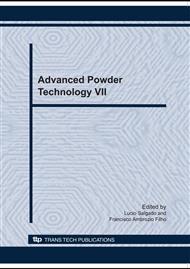p.128
p.133
p.139
p.145
p.152
p.158
p.164
p.170
p.176
Microstructural Evolution of Ti-10NB and Ti-15NB Alloys Produced by the Blended Elemental Technique
Abstract:
Alfa/beta titanium alloys have been intensely used for aerospace and biomedical applications. Production of powder metallurgy titanium alloys components may lead to a reduction in the cost of parts, compared to those produced by conventional cast and wrought (ingot metallurgy) processes, because additional working operations (machining, turning, milling, etc.) and material waste can be avoided. In this work, samples of Ti- 10, 15Nb (weight%) alloys were obtained by the blended elemental technique using hydride-dehydride (HDH) powders as raw material, followed by uniaxial and cold isostatic pressing with subsequent densification by sintering carried out in the range 900–1500 °C. These alloys were characterized by X-ray diffractometry for phase composition, scanning electron microscopy for microstructure, Vickers indentation for hardness, Archimedes method for specific mass and resonance ultrasound device for elastic modulus. For the samples sintered at 1500°C it was identified and phases. It was observed the influence of the sintering temperatures on the final microstructure. With increasing sintering temperature, microstructure homogenization of the alloy takes place and at 1500 °C this process is complete. The same behavior is observed for densification. Comparing to the Ti6Al4V alloy properties, these alloys hardness (sintered at 1500 °C) are near and elastic modulus are 18% less.
Info:
Periodical:
Pages:
152-157
Citation:
Online since:
October 2010
Price:
Сopyright:
© 2010 Trans Tech Publications Ltd. All Rights Reserved
Share:
Citation:


